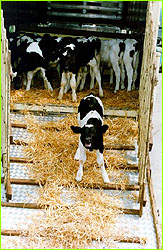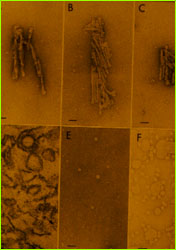 |
When Science Faces the Unknown by Joseph S. Levine Bovine Spongiform Encephalopathy (B.S.E.), nicknamed "Mad Cow Disease" was as unanticipated as AIDS, and is arguably as insidious. It arose from centuries of relative obscurity in sheep to sweep through British cattle herds with staggering speed. It is caused by an infectious agent whose precise identity is still in dispute. It seems to be unusually adept at breaking through the biochemical barriers that usually make it impossible for disease-causing organisms to jump from one species to another. It has already caused the deaths of at least 20 humans, most of them young. And it may be incubating within an unknown number of people who have consumed British beef products over the last decade. These gruesome facts alone make the story worth telling. Yet this is not just a singular cautionary tale; it also provides classic examples of uncertainty in the process of science, the complex and vital  relationship between science and society, and the role of science in coping
with the side-effects of human changes to the environment. Precisely because
the structure and general lessons of this story are not unique, we should be
careful not to pigeonhole this chain of events as an unfortunate aberration.
Here's why.
relationship between science and society, and the role of science in coping
with the side-effects of human changes to the environment. Precisely because
the structure and general lessons of this story are not unique, we should be
careful not to pigeonhole this chain of events as an unfortunate aberration.
Here's why.A new infectious agent? In most textbooks, "the scientific method" is described simply as a rational and objective series of steps that progress incrementally towards a better understanding of the natural world. Happily, that is sometimes the case, but the process of science is not always so linear. The ongoing debate about the nature of the infectious agent that causes B.S.E. offers a case in point. The dominant camp asserts that "Mad Cow Disease" and other transmissible spongiform encephalopathies (T.S.E.s) are caused by a new kind of infectious agent: a form of protein called a prion. According to the prion hypothesis, championed by American neurologist and biochemist Stanley Prusiner, this lethal protein can be likened to the "evil twin" of a normal protein called PrP, which is present in healthy nerve cells. Somehow, the evil twin molecule is thought to attach itself to a normal PrP protein molecule, convert it into another prion, and repeat this operation slowly but indefinitely. Subverted protein molecules attach to one another, forming clumps called plaques that damage nervous tissue and cause disease. Now, to a non-scientist, the notion that disease can be caused by a naked protein might seem no more or less outlandish than any other revelation churned
What are the experimental data that lead to such heresy? Pickling in concentrated formalin, autoclaving at high temperatures, bombardment with intense radiation, and exposure to powerful ultra-violet light all destroy nucleic acids—and inactivate known viruses. Yet these treatments have no effect on the ability of the T.S.E. infectious agent to cause disease in a new host. Whatever that agent is, it is small enough that it cannot be visualized, even by electron microscopes that reveal the tiniest viruses yet known to science. (Clumps of protein fibrils caused by the plaques that accumulate in cases of T.S.E. can be seen in electron micrographs, but researchers have yet to make positive visual identification of the infectious agent itself.) Furthermore, animals infected by this mysterious agent produce no antibodies against it. Even the unusual Human Immunodeficiency Virus provokes an antibody response from the immune system. Dissenters to the prion hypothesis argue that Prusiner's evidence does not add up to incontrovertible proof that protein alone is responsible for T.S.E.s. Some postulate the existence of a unique combination of protein and a tiny piece of DNA or RNA—a combination they call a "virion" or "virino" that is somehow resistant to the treatments that usually destroy nucleic acid. Others insist that the prion camp has not successfully demonstrated Koch's postulates. These well-established procedures for positively identifying infectious agents were established by Robert Koch. They include: proving that the agent is present in every case of the disease; isolating the agent from the host and growing it independently; producing the disease by inoculating a pure culture of the agent into a healthy host; and recovering the same agent from the experimentally infected host. Without delving into the largely technical dialogue between these camps, we can view this situation as an example of how science deals with major shifts in its notion of how the world operates. When such changes in perspective are truly earth shaking—as was Galileo's replacement of an earth-centered view of the solar system with a sun-centered model—they are called paradigm shifts. They are never made easily, and are often surrounded (as they should be) by controversy. (The classic discussion of paradigm shifts in science can be found in Thomas Kuhn's book "The Structure of Scientific Revolutions.") Compared to the philosophical repercussions of Galileo's work, the ramifications of Prusiner's are relatively minor. Nonetheless, if this work is confirmed, it will rank among the most important biological discoveries of the 20th century. The Role of Skepticism In this case, as in others, scientists view data that do not fit into established models of the world with skepticism. This skepticism is an integral and essential part of science that distinguishes it from other ways of thinking. The function of skepticism in science is to encourage efforts to prove or disprove a rogue hypothesis. If new findings are upheld, they create a gradually building acceptance that, at some point, sparks a transformation in the way scientists think. (The comparatively sudden acceptance of the prion hypothesis was demonstrated by Prusiner's receipt of the 1997 Nobel Prize in Physiology or Medicine.) Even after a scientific paradigm shifts, however, dissent from the new model typically persists. In some situations, ongoing dissent is valuable; it may encourage advocates of new views to undertake further, even more extensive and rigorous testing of their ideas. In other situations, continuing dissent can be counterproductive, particularly if it encourages individuals or organizations to base important decisions on demonstrably false logic. In this regard, the attention of the mass media, whose practitioners are often marginally literate in science, can be either a blessing or a curse. The journalistic imperative to seek out an opinion from an opposing point of view sometimes offers disproportionate weight to contrary pronouncements by marginal thinkers. Parallels with AIDS In some ways, the recent history of investigations into the cause of T.S.E. parallels that of another recent "mystery" disease—AIDS. In both situations, a radically new and previously unknown infectious agent was involved. In both
Furthermore, in the case of AIDS, as in that of T.S.E.s, some debate concerning cause and effect still lingers. Virtually all clinical researchers and epidemiologists who actually work with AIDS agree that HIV is its root cause. But a small, dedicated cadre of academic dissenters, led by two highly regarded researchers, continues to disagree—arguing, in part, that Koch's postulates have still not been demonstrated for HIV. Joe Levine is a biologist, educator, and science journalist. He is the author of six books and numerous articles on scientific subjects, and the co-author (with Kenneth Miller) of two widely acclaimed biology textbooks for high school and college students. Photos: (1) Express Newspapers/Archive Photos; (2) Visuals Unlimited/©Stanley B. Prusiner; (3) Visuals Unlimited/©David M. Phillips. When Science Faces the Unknown | 20/20 Hindsight Food Safety Tips | Do Prions Exist? Teacher's Guide | Resources | Transcript | Brain Eaters Home Editor's Picks | Previous Sites | Join Us/E-mail | TV/Web Schedule About NOVA | Teachers | Site Map | Shop | Jobs | Search | To print PBS Online | NOVA Online | WGBH © | Updated November 2000 |
||||||||

